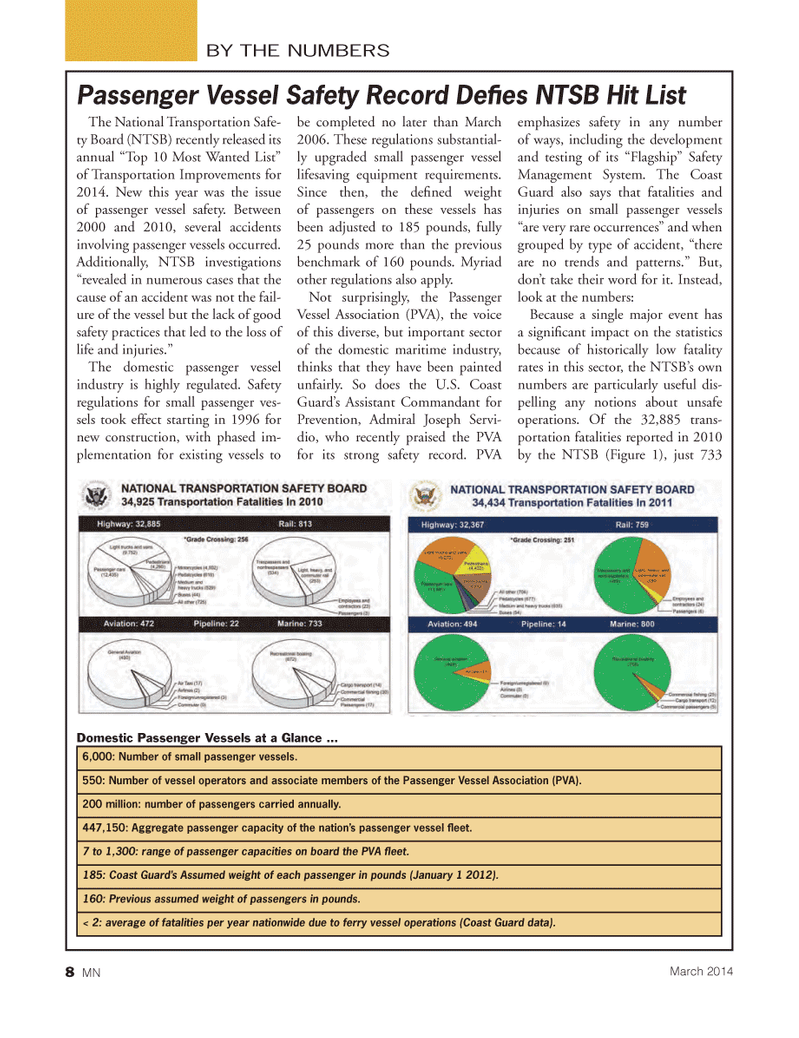
Page 8: of Marine News Magazine (March 2014)
Fleet & Vessel Optimization
Read this page in Pdf, Flash or Html5 edition of March 2014 Marine News Magazine
BY THE NUMBERS
The National Transportation Safe- ty Board (NTSB) recently released its annual “Top 10 Most Wanted List” of Transportation Improvements for 2014. New this year was the issue of passenger vessel safety. Between 2000 and 2010, several accidents involving passenger vessels occurred.
Additionally, NTSB investigations “revealed in numerous cases that the cause of an accident was not the fail- ure of the vessel but the lack of good safety practices that led to the loss of life and injuries.”
The domestic passenger vessel industry is highly regulated. Safety regulations for small passenger ves- sels took effect starting in 1996 for new construction, with phased im- plementation for existing vessels to be completed no later than March 2006. These regulations substantial- ly upgraded small passenger vessel lifesaving equipment requirements.
Since then, the defi ned weight of passengers on these vessels has been adjusted to 185 pounds, fully 25 pounds more than the previous benchmark of 160 pounds. Myriad other regulations also apply.
Not surprisingly, the Passenger
Vessel Association (PVA), the voice of this diverse, but important sector of the domestic maritime industry, thinks that they have been painted unfairly. So does the U.S. Coast
Guard’s Assistant Commandant for
Prevention, Admiral Joseph Servi- dio, who recently praised the PVA for its strong safety record. PVA emphasizes safety in any number of ways, including the development and testing of its “Flagship” Safety
Management System. The Coast
Guard also says that fatalities and injuries on small passenger vessels “are very rare occurrences” and when grouped by type of accident, “there are no trends and patterns.” But, don’t take their word for it. Instead, look at the numbers:
Because a single major event has a signifi cant impact on the statistics because of historically low fatality rates in this sector, the NTSB’s own numbers are particularly useful dis- pelling any notions about unsafe operations. Of the 32,885 trans- portation fatalities reported in 2010 by the NTSB (Figure 1), just 733
Passenger Vessel Safety Record Defi es NTSB Hit List 6,000: Number of small passenger vessels. 550: Number of vessel operators and associate members of the Passenger Vessel Association (PVA). 200 million: number of passengers carried annually. 447,150: Aggregate passenger capacity of the nation’s passenger vessel fl eet. 7 to 1,300: range of passenger capacities on board the PVA fl eet. 185: Coast Guard’s Assumed weight of each passenger in pounds (January 1 2012). 160: Previous assumed weight of passengers in pounds. < 2: average of fatalities per year nationwide due to ferry vessel operations (Coast Guard data).
Domestic Passenger Vessels at a Glance … 8 MN
March 2014
MN MAR14 Layout 1-17.indd 8 2/21/2014 3:16:10 PM

 7
7

 9
9
